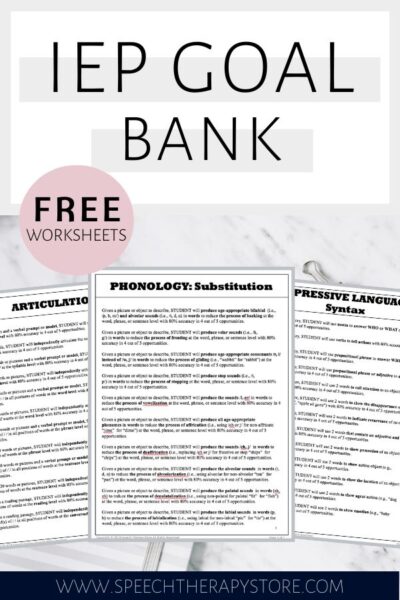I’m excited to share with you today my articulation goals, which are an essential part of the speech therapy progress for those wanting to improve their articulation skills.
The speech goals I’ve outlined below involve addressing specific phonemes, or speech sounds, that an individual has difficulty pronouncing. The goal is to help your student or client to develop clear and intelligible speech.
You as the Speech-Language Pathologists (SLPs) play a crucial role in identifying, assessing, and creating personalized articulation goals for individuals with speech disorders.
It is important to keep in mind that articulation disorders are when a student has difficulty with a specific consonant or vowel sound, unlike phonological disorders which are when the student is having broader issues affecting whole words or phrases.
By working closely with an SLP, individuals can receive tailored therapeutic approaches, such as auditory and tactile cueing or modeling techniques, to address their unique articulation needs.
As your students make progress, articulation goals should be adjusted to continually demonstrate growth and improvement in your student’s speech sound production.

Key Takeaways
- Articulation goals are essential in speech therapy for addressing specific speech sound difficulties.
- Speech-language pathologists create personalized goals and therapeutic approaches for individuals with articulation disorders.
- Progress towards articulation goals is continually assessed and adjusted to promote growth in speech sound production.
Understanding Articulation Goals
The First Step
Before diving into articulation goals, you should understand the first step in articulation therapy.
- It’s essential to identify the sounds or phonemes with which the person has difficulty.
- By assessing these challenges, the speech therapist can develop tailored goals to help the individual work on their specific articulation needs.
- A great starting point would be to use a standardized test, such as the Goldman-Fristoe Test of Articulation or another articulation test or screener as a great way to determine which sounds the student is struggling with and where to begin therapy.
- In the initial phase of therapy, the ability to make sounds correctly at the word level in different word positions (initial position, medial position, or final position) is crucial, as it establishes the groundwork for developing accurate speech articulation.

Purpose of Articulation Goals
The purpose of articulation goals is to improve communication skills for individuals who face challenges in pronouncing words or sounds. These goals are what help guide your students’ speech therapy sessions to ensure the student or client actually makes progress toward their articulation skills.
When creating articulation goals, speech therapists should consider various aspects, such as the phonemes involved, the position of the sounds within words (initial, medial, or final), and the student’s age-appropriateness to be working on those particular goals.
Articulation goals usually include:
- Targeting specific sounds at the phonemic level, word level, phrase level, sentence level, reading level, and conversational level
- Increasing accuracy in producing the target sound
- Enhancing the intelligibility of the individual’s speech
- Encouraging self-monitoring and self-correction during conversations
The success of articulation therapy relies on consistent practice, feedback, and the development of personalized goals that best address the student’s unique needs.
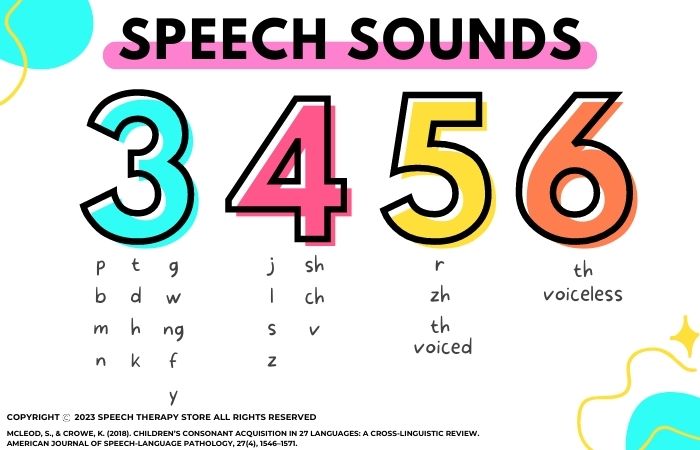
The Role of Speech-Language Pathologists
Best Practice
As a speech language pathologist (SLP), your primary focus is on implementing a best practice approach to treat articulation disorders. This approach involves prevention, identification, assessment, intervention, monitoring, and follow-up of speech sound disorders. By staying up-to-date with current research and utilizing evidence-based practices, you can ensure that your clients receive the most effective treatment possible.
Your best practice should involve:
- Collaborating with other professionals, such as teachers and special education staff, to provide comprehensive care and support
- Individualizing treatment plans that cater to the specific needs and abilities of each client
- Monitoring progress and adjusting treatment plans as needed to optimize outcomes
Treatment Plans
Developing a well-structured treatment plan is essential for how we can best address our student’s articulation goals. As an SLP, we need to create individualized treatment plans that cater to the unique needs of your clients and students.
An effective treatment plan should:
- Assess the client’s needs: Begin by conducting a thorough evaluation, noting the client’s strengths, weaknesses, and areas for improvement. This will help you identify the specific speech sounds they have difficulty with, as well as any underlying issues causing these difficulties.
- Set clear goals: Establish specific, measurable, attainable, relevant, and time-bound (SMART) goals for the client. These goals should focus on improving the problematic speech sounds and their overall articulation abilities.
- Select appropriate interventions: Choose evidence-based interventions that have been proven effective for similar clients and issues. These may include articulation drills or different levels of modeling or prompting.
- Monitor progress: Regularly assess the client’s progress using objective data collected during therapy sessions. This will help you determine if the interventions are working and make any necessary adjustments to the treatment plan.
- Communicate with caregivers: It’s important to keep caregivers informed about the client’s progress, and provide them with information and resources to support the client’s speech sound development at home.

By following best practices and designing tailored treatment plans for your clients, you can confidently and effectively address your students or clients’ articulation goals.
Depending on the standardized test results, screenings, language samples, and parent or guardian information therapy may be articulation-focused, phonological-focused, or a combination of both.
This will depend on the individual student or client and based on their testing results.
The following information focuses on an articulation focused therapy plan.
4 Types of Articulation Disorders
Speech Sounds
Articulation disorders can be characterized by difficulties in producing specific speech sounds.
Children struggling with this type of disorder may have trouble with certain consonants or vowels.
It’s essential to identify and address these issues early on, as they can impact a child’s overall speech and communication abilities.
Examples of speech sound challenges are mispronouncing any of the following sounds /p, b, t, d, k, g, f, v, m, n, w, r, l, s, z, ch, sh, th, j, h, zh, ng, y/.

- Substitution – Is when a sound is substituted with another sound. For example, when /r/ sound is substituted with the /w/ sound, such as “wed” for “red” or “wing” for “ring”.
- Distortion – A distortion is when the sound is not exactly like the natural sound within a word, such as a lateral or interdental lisp of the /s/ or /z/ sound.
- Lateral Lisp – A lateral lisp or lateral distortion happens when air escapes out the sides of your teeth. To help reduce a lateral lisp encourage your client or student to place the sides of their tongue against the upper side of their teeth to allow the passage of air to go down the center of the tongue instead of out the sides of the teeth. The lateral lisp sounds like a “slushy” s sound.
- Interdental List or Frontal List – An interdental lisp or frontal lisp happens when the tongue protrudes between the front teeth. This causes the s and z sound to be produced as the /th/ sound. The word ‘sleep’ is then pronounced as ‘theep’.
- Omission – Is when a sound is deleted or omitted from a word. For example, “pot” for “spot” by deleting the /s/ sound from the word.
- Addition – Is when a sound is added to a word. For example, adding the sound /p/ in “hampster” for “hamster”.

Phonological Processes
It is important to note that phonological processes refer to the patterns of speech errors observed in children that are rule-based and predictable errors.
Instead of articulation errors of individual sounds these patterns involve a systematic simplification of more than one sound, such as:
- Fronting: Substituting a sound made in the front of the mouth for a back sound. For example, when the /k/ or /g/ back sounds are substituted for the front sounds /t/ or /d/, such as “tan” for “can” or “dough” for “go”.
- Stopping: Replacing a continuous fricative sound with a stop sound. For example, replacing /s/ or /f/ with /t/ or /p/ as in “tea” for “sea” or “pan” for “fan”. For more resources on the phonological process of stopping be sure to check out our list of over 31 free stopping activities.
- Cluster Reduction: This is when a consonant cluster, which is 2 or 3 consonants occurring in a sequence in a word (sp in spot) or (st in stop) is reduced to a single consonant through deletion. For example, “pider” for “spider” or “top” for “stop”.
- Final Consonants Deletion: The phonological process of final consonant deletion is when the final consonant sound is omitted or deleted. For example, the word “road” would become “row”
However, identifying and addressing these phonological processes can help improve a child’s overall speech and articulation abilities.
*Get our complete list of phonological processes here.

Therapeutic Approaches to Articulation Goals
Auditory Bombardment
Auditory bombardment is when the speech pathologist says a list of words containing the sound(s) the student is working on. This allows the child to hear the correct pronunciation of their sound or sounds.
For example, if the student was working on the /t/ sound the therapist would read a list of words containing the /t/ sound for the child to be exposed to the correct production of that sound.
When working with young children you could also send a list of words home for different family members to read the list of words aloud to provide the child with even more auditory bombardment at home.
Isolation Level
The Isolation level is when the specific sound is produced at just the sound level. For example, if the student is working on the /b/ sound then they would practice saying /b/.
Syllable Level
The syllable level is when the specific sound is produced at just the syllable level. For example, if the student is working on the /f/ sound then they would practice the syllable “fa-” in the word “fa-ther”.
Word Level
The word level is when the specific sound is produced in single words. For example, if the student is working on the /v/ sound they would practice the words “van”, “vroom”, “vest”.
Phrase Level
The phrase level is when the specific sound is produced in a phrase. For example, if the student was working on the /k/ sound they could practice the phrase, “fast cat” or “orange cat”.
Sentence Level
The sentence level is when the specific sound is produced in a sentence. For example, if the student was working on the /p/ sound they could practice the sentence, “The pancake is fluffy.” or “The pen has black ink.”
Reading Level
The reading level is when the child is given a reading passage or short story and produces their different articulation sounds while reading.
Functional Communication
A primary goal of articulation therapy is to improve functional communication, which refers to your ability to convey thoughts and ideas effectively in various daily situations.
Incorporating functional communication activities within your therapy sessions can boost your students’ confidence and motivation to apply their newly acquired speech skills in real-life contexts.
Examples of functional speech tasks include role-playing, using targeted sounds in socially relevant conversations, and practicing greetings or introductions.
Language Tasks
Incorporating expressive language tasks into your articulation therapy sessions can enhance your student’s ability to target their speech sound goals.
You may work on activities such as storytelling, sentence building, and word formations.
Utilize age-appropriate materials and engage in conversations that are meaningful and motivating for the client.
By doing so, you can actively practice targeted sounds while simultaneously addressing your student’s language therapy, vocabulary words, and overall communication.
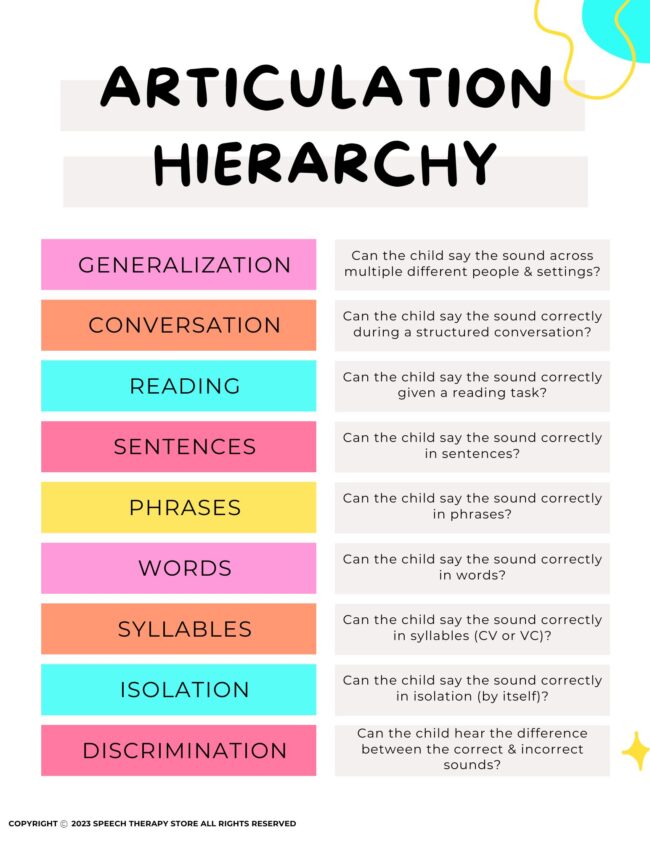
Speech Therapy Goals
School Setting
In the school setting, speech and language therapists will work closely with the student’s classroom teachers, staff, and parents to support the student’s communication needs.
In order to address the diverse requirements of students with different backgrounds and abilities, it is essential to establish clear, concise, and achievable goals.
If you are a parent it is important to collaborate with your child’s speech therapist to develop articulation goals that align with their Individualized Education Plan (IEP) or 504 Plan.
It is also important to encourage the school staff to provide consistent support for your child, such as implementing accommodations, providing specialized instruction, or offering speech therapy sessions.
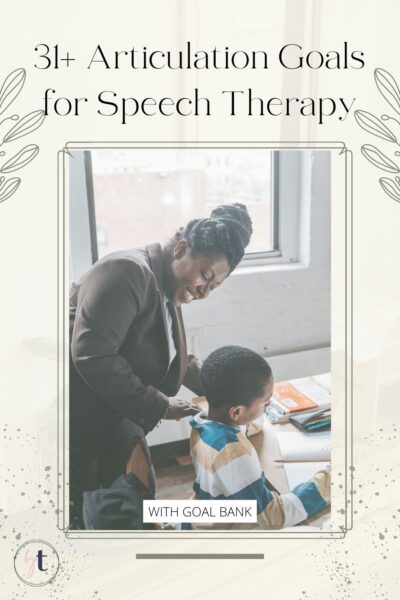
SMART Goals
Establishing clear speech therapy goals is essential for setting a roadmap for your progress in articulation therapy.
Using the SMART goal words, described below, are helpful tools to help you get started writing IEP goals.
Goals should be SMART:
- Specific – The goal should name the skill or subject area as well as the targeted result.
For example, “By the end of the quarter, given 20 words or pictures and verbal prompts, STUDENT will articulate the /vocalic r/ sound at the word level with 80% accuracy over three consecutive sessions.”
- Measurable – The goal is written in such a way that the student’s progress can be measured.
For example, “By the end of the quarter, given 20 words or pictures and verbal prompts, STUDENT will articulate the /vocalic r/ sound at the word level with 80% accuracy over three consecutive sessions.”
- Attainable – The goal is achievable and is realistic for your student or client to reach. Along with any support the student may need to achieve the goal.
For example, “By the end of the quarter, given 20 words or pictures and verbal prompts, STUDENT will articulate the /vocalic r/ sound at the word level with 80% accuracy over three consecutive sessions.”
- Relevant – The goal is individualized to that individual student and is meaningful and realistic for that specific student.
For example, “By the end of the quarter, given 20 words or pictures and verbal prompts, STUDENT will articulate the /vocalic r/ sound at the word level with 80% accuracy over three consecutive sessions.”
- Time-Bound – It is important that the goal include a time frame in which the student can achieve their goal.
For example, “By the end of the quarter, given 20 words or pictures and verbal prompts, STUDENT will articulate the /vocalic r/ sound at the word level with 80% accuracy over three consecutive sessions.”
It is helpful to break down your student’s goals into smaller objectives, focusing on particular speech sounds, and tracking progress over time.

Sample Goal
For example, a goal could be “By the end of the quarter, given 10 words or pictures and carrier phrases, STUDENT will articulate the /s/ sound at the sentence level with 80% accuracy over three consecutive sessions.”
As your student achieves their short-term goals, you can work towards them mastering more complex articulation tasks, such as using their targeted speech sounds in connected speech.
Regularly reviewing your student’s goals helps to ensure their therapy sessions remain focused and tailored to their individual needs.

Selecting Sounds to Target
A goal bank is a comprehensive collection of pre-written objectives tailored to various speech and language difficulties.
- Developmental – This is when you choose which sounds to target first based on when they are developmentally developed.
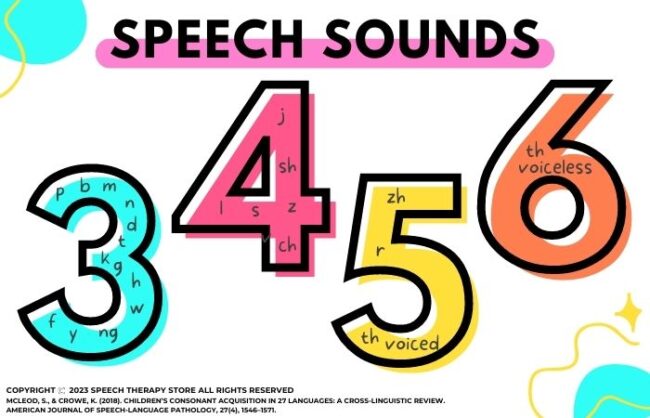
For example, if a student’s speech sound disorder includes both the /r/ and /b/ sound you would begin with the /b/ sound first because it is developmentally developed by the age 2 or early while the /r/ sound is developed around age 6.

- Theory Based –
- Complexity – This is when you focus on the more difficult or complex phonological elements that are not yet part of a child’s communication skills yet to help encourage a cascading effect that will hopefully generalize across sounds (Gierut, 2007; Storkel, 2018).
- Dynamic Systems – This strategy focuses on teaching and learning simple phonemes and avoiding introducing new contrasts into the child’s phonological systems to help the child acquire their target sounds (Rvachew & Bernhardt, 2010).
- Systemic – This strategy focuses on the function of the sound within the child’s phonological system to help make the biggest impact of reorganized their phonological system with the least amount of intervention. A target sound is then chosen based on it be maximally distinct from the child’s errors in place, voice, and manner (Williams, 2003b).
- Client Specific – This is when you select the target sounds based on the relevance to the child, such as a phoneme in their name or their stimulability for certain sounds.
- Intelligibility – For this strategy it depends on the child’s errors and picking the sounds or error patterns that would have the biggest overall impact based on their intelligibilty level.
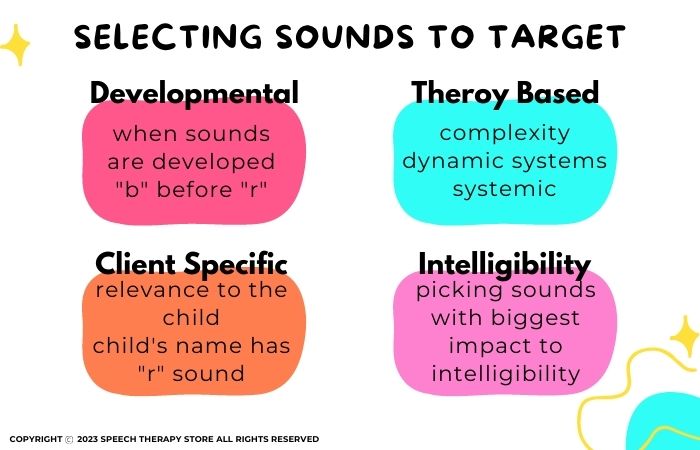
Articulation Goals
Long Term Goal Bank
A goal bank is a comprehensive collection of pre-written objectives tailored to various speech and language difficulties.
Utilizing a goal bank allows you to easily reference and customize goals for your child’s ability and specific needs, saving time and ensuring the objectives are achievable and relevant.
For example, you may find goals targeting the production of specific sounds in the initial, medial, or final positions in words, phrases, or sentences. (see below)
Goal banks can be an invaluable resource when creating plans for early intervention, school settings, or home-based therapy, as they provide a clear framework for tracking progress and ensuring consistency in treatment.
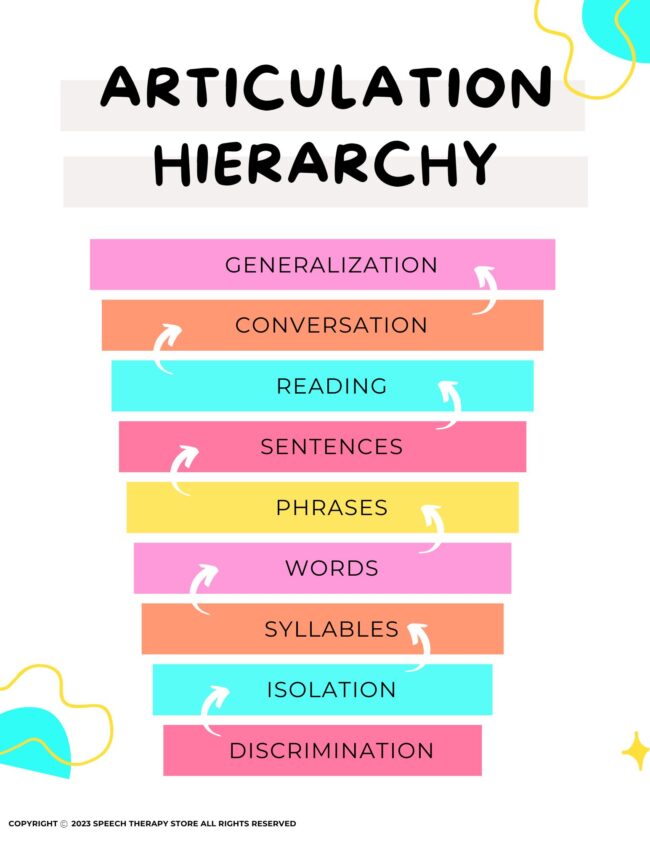
Auditory Discrimination
Given 10 words, STUDENT will recognize the differences between the same or different words with 80% accuracy in 4 out of 5 opportunities.
Given a word broken down into isolated sounds, STUDENT will combine the isolated sounds together to form words with 80% accuracy in 4 out of 5 opportunities.
Isolation Level
Given 20 sounds and a verbal prompt or model, STUDENT will articulate the sound(s) of / / at the isolation level with 80% accuracy in 4 out of 5 opportunities.
Given 20 sounds, STUDENT will independently articulate the sound(s) of / / at the isolation level with 80% accuracy in 4 out of 5 opportunities.
Syllable Level
Given 20 words or pictures and a verbal prompt or model, STUDENT will articulate the sound(s) of / / at the syllable level with 80% accuracy in 4 out of 5 opportunities.
Given 20 words or pictures, STUDENT will independently articulate the sound(s) of / / at the syllable level with 80% accuracy in 4 out of 5 opportunities.
Word Level
Given 20 words or pictures and a verbal prompt or model, STUDENT will articulate the sound(s) of / / in all positions of words at the word level with 80% accuracy in 4 out of 5 opportunities.
Given 20 words or pictures, STUDENT will independently articulate the sound(s) of / / in all positions of words at the word level with 80% accuracy in 4 out of 5 opportunities.
Phrase Level
Given 20 words or pictures and a verbal prompt or model, STUDENT will articulate the sound(s) of / / in all positions of words at the phrase level with 80% accuracy in 4 out of 5 opportunities.
Given 20 words or pictures, STUDENT will independently articulate the sound(s) of / / in all positions of words at the phrase level with 80% accuracy in 4 out of 5 opportunities.
Sentence Level
Given 20 words or pictures and a verbal prompt or model, STUDENT will articulate the sound(s) of / / in all positions of words at the sentence level with 80% accuracy in 4 out of 5 opportunities.
Given 20 words or pictures, STUDENT will independently articulate the sound(s) of / / in all positions of words at the sentence level with 80% accuracy in 4 out of 5 opportunities.
Reading Level
Given 20 words or pictures and a verbal prompt or model, STUDENT will articulate the sound(s) of / / in all positions of words at the reading level with 80% accuracy in 4 out of 5 opportunities.
Given a reading passage, STUDENT will independently articulate the sound(s) of / / in all positions of words at the reading level with 80% accuracy in 4 out of 5 opportunities.
Conversational Level
Given a reading passage, STUDENT will independently retell the story by articulating the sound(s) of / / in all positions of words at the conversational level with 80% accuracy in 4 out of 5 opportunities.
Given a reading passage, STUDENT will independently answer WH questions by articulating the sound(s) of / / in all positions of words at the conversational level with 80% accuracy in 4 out of 5 opportunities.
Given a structured activity, STUDENT will independently articulate the sound(s) of / / in all positions of words at the conversational level with 80% accuracy in 4 out of 5 opportunities.
Given a conversational topic, STUDENT will independently articulate the sound(s) of / / in all positions of words at the conversational level with 80% accuracy in 4 out of 5 opportunities.
Substitutions
Given 20 words or pictures and a verbal prompt or model, STUDENT will decrease the substitution of the / / sound for the / / sound in all positions of words at the word level with 80% accuracy in 4 out of 5 opportunities.
Given 20 words or pictures and a verbal prompt or model, STUDENT will decrease the substitution of the / / sound in all positions of words at the word level with 80% accuracy in 4 out of 5 opportunities.
Given 20 words or pictures, STUDENT will independently decrease the substitution of the / / sound for the / / sound in all positions of words at the word level with 80% accuracy in 4 out of 5 opportunities.
Given 20 words or pictures, STUDENT will independently decrease the substitution of the / / sound in all positions of words at the word level with 80% accuracy in 4 out of 5 opportunities.
Distortions
Given 20 words or pictures and a verbal prompt or model, STUDENT will decrease distortions of the / / sound in all positions of words at the word level with 80% accuracy in 4 out of 5 opportunities.
Given 20 words or pictures, STUDENT will independently decrease distortions of the / / sound in all positions of words at the word level with 80% accuracy in 4 out of 5 opportunities.
Omissions
Given 20 words or pictures and a verbal prompt or model, STUDENT will decrease omissions of the / / sound in all positions of words at the word level with 80% accuracy in 4 out of 5 opportunities.
Given 20 words or pictures, STUDENT will independently decrease omissions of the / / sound in all positions of words at the word level with 80% accuracy in 4 out of 5 opportunities.
Additions
Given 20 words or pictures and a verbal prompt or model, STUDENT will decrease additions of the / / sound in words (such as, ) at the word level with 80% accuracy in 4 out of 5 opportunities.
Given 20 words or pictures, STUDENT will independently decrease additions of the / / sound in words (such as, ) at the word level with 80% accuracy in 4 out of 5 opportunities.
Self-Monitoring
Given a conversational topic, STUDENT will self-monitor articulation of the sound(s) of / / in all positions of words at the reading level with 80% accuracy in 4 out of 5 opportunities.
Given a conversational topic, STUDENT will self-monitor articulation of the sound(s) of / / in all positions of words at the conversational level with 80% accuracy in 4 out of 5 opportunities.
Generalization
Given a classroom discourse, STUDENT will generalize articulation of the sound(s) of / / in all positions of words at the conversational level outside of the therapy setting with 80% accuracy in 4 out of 5 opportunities.
Given a community outing, STUDENT will generalize articulation of the sound(s) of / / in all positions of words at the conversational level outside of the therapy setting with 80% accuracy in 4 out of 5 opportunities.
SEE ALSO: 75+ Receptive Language Goals (Goal Bank)
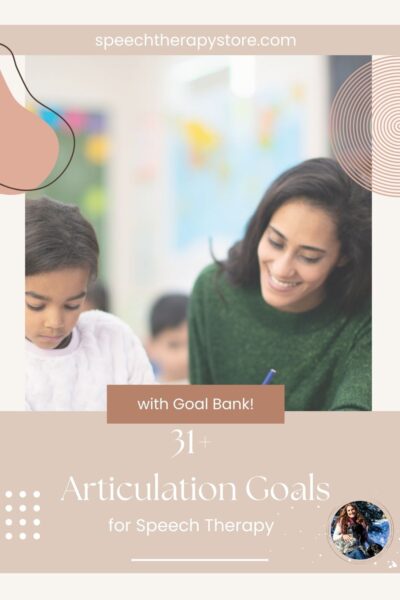
Speech Therapy Goals – Short-Term Goals Objectives
I know every district has different ways it requires their objectives to be written, but typically my district wanted us to reduce either the number required or the percentage of achievement.
Here are a few examples to help get you started.
If we take a sample goal:
“Given 20 words or pictures, STUDENT will independently articulate the /r/ sound in all positions of words at the sentence level with 80% accuracy over 3 out of 4 consecutive sessions.”
- Reduced Number or Trials Required: The objective might be, “Given 10 words or pictures, STUDENT will independently articulate the /r/ sound in all positions of words at the sentence level with 80% accuracy over 3 out of 4 consecutive sessions.”
- Reduce Percentage of Accuracy: The objective might be, “Given 20 words or pictures, STUDENT will independently articulate the /r/ sound in all positions of words at the sentence level with 70% accuracy over 3 out of 4 consecutive sessions.”
- Reduce Difficulty of Task: The objective might be, “Given 20 words or pictures and a verbal prompt or model, STUDENT will articulate the /r/ sound in the initial position of words at the sentence level with 80% accuracy over 3 out of 4 consecutive sessions.”
- Reduce Number of Sessions of Accuracy: The objective might be, “Given 20 words or pictures, STUDENT will independently articulate the /r/ sound in all positions of words at the sentence level with 80% accuracy over 2 out of 4 consecutive sessions.”
(Meaning out of 4 therapy sessions in a row 2 out of the 4 or 50% of the time they met their goal in order to mark that goal mastered.)
As the speech pathologist, you are the specialist and you know your students and child’s ability best though, so just take the goals and simplify them into achievable steps for your child’s specific articulation weaknesses.
Methods for Achieving Articulation Goals
Visual Prompts
Visual prompts or visual cues are an effective way to help you improve your student’s articulation skills.
These prompts may include a picture cue, picture card illustrations, or diagrams that represent the target sound or word.
You can use common objects like a mirror to help your student or client to observe their mouth movements while practicing their sounds.
When you incorporate visual aids into your practice it can make therapy more engaging and help your students master their articulation goals faster.
Another great idea for using visual prompts is to create flashcards with images representing the target sounds. This can be a fun and interactive way for your students to practice their articulation skills.
You can also use apps or software designed specifically for speech therapy, which often include visual prompts as part of their features.
Remember to practice regularly and consistently for the best results.
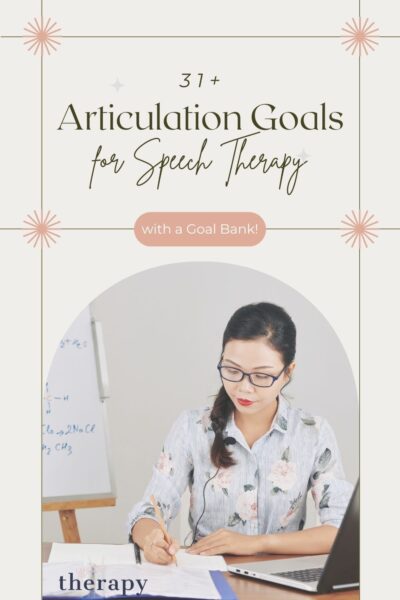
Verbal Prompts
Verbal prompts are another essential method for achieving your articulation goals.
These prompts may involve spoken instructions, cues, or examples that demonstrate the proper production of a sound.
When providing your students with a verbal prompt or verbal cue, you can focus on specific aspects of the sounds, such as their placement, manner, or voicing.
For example, to effectively use verbal prompts, you can have your student or client try repeating target sounds or words after you or a recorded model. This will help your students become more familiar with the correct production of the sound.
Additionally, try breaking down complex sounds into smaller components, focusing on perfecting each part before attempting the full sound. This step-by-step approach can be helpful in improving your students’ articulation skills.
Remember that consistent practice is crucial for progress. Incorporating both visual and verbal prompts into your routine will help your students reach their articulation goals more effectively.
SEE ALSO: 432+ Free Measurable IEP Goals and Objectives Bank
Measuring Progress Towards Articulation Goals
Data Collections
In order to know if your student is making progress it is essential that you as the therapist are measuring your student’s progress through data collection.
It is by consistently tracking your child or student’s progress that you can make informed decisions about therapy and more effectively communicate with other professionals or parents.
To ensure that you have the right measurable goals, focus on creating goals that are objectively measurable and specific to the individual’s needs. (see goals above)
Rating Scales
Another useful tool to gauge progress in articulation goals is by using rating scales.
Rating scales can help you monitor the individual’s self-awareness of their speech production and provide you with qualitative data points to supplement the quantitative data collected.
To effectively use rating scales, ensure that they are tailored to the target skills and can be easily understood by the individual.
This will enable them to self-monitor their speech accuracy and provide feedback for improvement.
Google Forms
Using Google Forms is another tool that provides a systematic way to track and monitor an individual’s progress toward their articulation goals.
By using Google Forms, you can record speech data, set measurable goals, and track progress in a single, organized system.
Additionally, using a Google Form allows for you to easily collaborate with other professionals and helps you evaluate the effectiveness of the therapy provided.
Google Forms How to Video
Watch this short video showing you exactly how to implement using Google Forms for your data collection.
Measurable Goals
Are you also looking for other speech therapy goals? If so, be sure to check out my master list of over 432 IEP goals here (including fluency goals, receptive language goals, and phonology goals just to name a few!).
SEE ALSO: Free Articulation Games for Speech Therapy
Frequently Asked Questions
What are common short-term goals for articulation?
Short-term goals for articulation typically involve working on specific speech sounds that the child is struggling with.
These goals might include mastering the production of a specific sound in isolation, improving accuracy in syllables, and increasing clarity in words and phrases. (see goal bank above)
How can articulation goals be adapted for young children aged 4 or 5?
For young children aged 4 or 5, articulation goals should be appropriate for their developmental level and learning style.
Goals may include working on producing age-appropriate sounds, understanding and using vocabulary, or participating in simple conversational exchanges.
Therapy activities should be engaging, interactive, and use multiple modes of learning to help young children progress toward their goals.
What is a typical IEP articulation goal?
A typical Individualized Education Program (IEP) articulation goal should be specific, measurable, achievable, relevant, and time-bound (SMART).
The goal should outline the targeted skill and the criteria for success, and it should be tailored to the individual needs of the child.
Please see the goal bank outlined above for specific examples of functional articulation IEP goals.
Can you provide examples of SMART goals in speech therapy?
Here are two examples of SMART goals in speech therapy:
- “By the end of the six-week period, the child will accurately produce the /s/ sound in 8 out of 10 word-initial positions during structured activities.”
- “Over the next three months, the child will increase their speech intelligibility in conversation from 60% to 80% as measured by the speech-language pathologist during therapy sessions.”
These goals are specific, measurable, achievable, relevant, and time-bound, which helps track progress and adjust treatment plans as needed.
How are goals set to improve speech intelligibility?
Goals to improve speech intelligibility often focus on addressing the production of specific sounds, reducing compensatory patterns, and increasing the clarity of words and phrases.
Speech-language pathologists typically use standardized assessments, observation, and input from caregivers and teachers to identify areas in need of improvement.
Goals should be tailored to the child’s needs and progress, considering the developmental progression of speech skills.
What are effective strategies for carryover in articulation goals?
Here are a few great ideas of effective strategies for the carryover of articulation goals into various settings include:
- Practicing targeted speech sounds and skills in different contexts, such as home, school, and community environments.
- Collaborating with teachers, caregivers, and other professionals to teach, reinforce, and generalize learned skills.
- Incorporating functional activities and natural opportunities for practice, such as conversations, storytelling, or playtime.
- Providing regular feedback, encouragement, and reminders to facilitate the child’s use of targeted skills in daily communication.
Conclusion
I hope you found this list of articulation goals helpful!
Feel free to spend less time creating your own articulation goals and copy and paste the goals above.
If you’re a family member wondering if your child has an articulation disorder then be sure to reach out to a local Speech-Language Pathologist to receive more formal testing.
Want Even More Articulation Therapy Ideas?
- 21 Best Reinforcement Games for Speech Therapy
- 261+ Free Ideas for Digital Therapy
- 917+ Best Free Boom Cards for Speech Therapy
- 11 Free Articulation Games for Speech Therapy
- Best Free Interactive PDF for Speech Therapy All-in-One
Want the Best of the Bests?
Be sure to check out our most popular posts below!
- 21 Best Reinforcement Games for Speech Therapy / Teletherapy
- Best IEP Resources
- 71+ Free Social Problem-Solving Scenarios
- 430+ Free Multisyllabic Words List Activity Bundle
- 432+ Free Measurable IEP Goals and Objectives Bank
- 279+ Free Speech Therapy Digital Materials
- 179+ Free Speech Therapy Wh-Questions Printable
References
DeVeney, S. L., Cabbage, K., & Mourey, T. (2020). Target Selection Considerations for Speech Sound Disorder Intervention in Schools. Perspectives of the ASHA Special Interest Groups, 5(6), 1722–1734.
Krueger, B. I. (2019). Eligibility and Speech Sound Disorders: Assessment of Social Impact. Perspectives of the ASHA Special Interest Groups, 4(1), 85–90.
McLeod, S., & Crowe, K. (2018). Children’s Consonant Acquisition in 27 Languages: A Cross-Linguistic Review. American Journal of Speech-Language Pathology, 27(4), 1546–1571.


